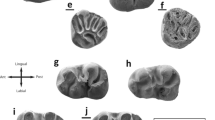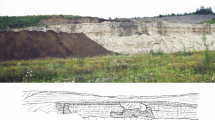Abstract
The late Miocene-early Pliocene fossil deposits of Hasnot in northern Pakistan have yielded a very rich vertebrate fauna. In this paper we describe the remains of Cervidae from six of these localities. By dental remains, at least four species of cervids are documented. These remains significantly widen the time distribution of the cervids and draw back the first appearance of cervids in the Dhok Pathan Formation of the Siwaliks. The data indicate a diverse set of coexisting ungulates in the area, subsisting within a mosaic of habitats.
Similar content being viewed by others
References
Akhtar, M. (1992) Taxonomy and Distribution of the Siwalik Bovids. Ph.D. Dissert. (unpublished), University of the Punjab, Lahore, Pakistan, pp.475.
Arif, M. and Raza, S.M. (1991) New findings of Cervidae (Mammalia) from the Upper Siwaliks of Potwar-Mirpur Areas, Pakistan. Proc. Pak. Congr. Zool., v.11, pp.275–281.
Arif, M., Shah, S.M.I. and Vos, J.D. (1991a) Cervus rewati sp. nov. (Mammalia, Cervidae) from the Upper Siwaliks of Pakistan. Geol. Surv. Pak., Mem., no.17, pt.11.
Arif, M., Shah, S.M.I. and Vos, J.D. (1991b) Cervus triplidens (Mammalia, Cervidae) from the Upper Siwaliks of Pakistan. Geol. Surv. Pak., Mem., no.17, pt.11.
Azzaroli, A. (1954) Critical observations upon Siwalik deer. Proc. Linn. Soc. London, pp.75–87.
Barry, J., Morgan, M., Flynn, L., Pilbeam, D., Behrensmeyer, A.K., Raza, S., Khan, I., Badgely, C., Hicks, J. and Kelley, J. (2002) Faunal and Environmental change in the Late Miocene Siwaliks of Northern Pakistan. Paleobiol., v.28, pp.1–72.
Behrensmeyer, A. and Barry, J. (2005) Biostratigraphic Surveys in the Siwaliks of Pakistan. A Method for Standardized Surface Sampling of the Vertebrate Fossil Record. Palaeont. Electr., v.8(1), pp.1–24.
Bernor, R.L. and Hussain, S.T. (1985) An assessment of the systematics phylogenetic and biogeographic relationships of Siwalik Hipparionine Horses. Jour. Vert. Palaeont., v.5(1), pp.32–87.
Bhatti, Z.H. (2005) Taxonomy, Evolutionary History and Biogeography of the Siwalik Giraffids. Ph.D. Dissert. (unpublished), University of the Punjab, Lahore, Pakistan, 372p.
Bibi, F. (2007) Origin, Paleoecology, and Paleobiogeography of early Bovini. Palaeogeogr., Palaeoclimat., Palaeoecol., v.248, pp.60–72.
Bibi, F., Bukhsianidze, M., Gentry, A. W., Geraads, D., Kostopoulos, D. S. and Vrba, E. S. (2009) The Fossil Record and Evolution of Bovidae: State of the Field. Palaeont. Electron., v.12(3), pp.1–11.
Brown, B. (1926) A new deer from the Siwalik. Novitates, vol.242, pp.1–6.
Colbert, E.H. (1935) Siwalik Mammals in the American Museum of Natural History. Transact. Amer. Philos. Soc. N. S., v.26, pp.1–401.
Dennell, R. (2008) The Taphonomic Record of Upper Siwalik (Pinjor stage) Landscapes in the Pabbi Hills, Northern Pakistan, with consideration regarding the preservation of Hominin remains. Quart. Int., v.192, pp.62–77.
Farooq, U., Akbar Khan, M., Akhtar, M. and Khan, A.M. (2008) Lower Dentition of Dorcatherium majus (Tragulidae, Mammalia) in the Lower and Middle Siwaliks (Miocene) of Pakistan. Turk. Jour. Zool., v.32, pp.91–98.
Farooq, U., Khan, M.A., Akhtar, M. and Khan, A.M. (2007a) Dorcatherium minus from the Siwaliks, Pakistan. Jour. Ani.Pl. Sci., v.17(3–4), pp.86–89.
Farooq, U., Khan, M.A., Akhtar, M. and Khan, A.M. (2007b) Dorcatherium majus, a study of upper dentition from the Lower and Middle Siwaliks of Pakistan. Jour. Appld. Sci., v.7(9), pp.1299–1303.
Farooq, U., Khan, M.A., Akhtar, M. and Khan, A.M. (2007c) Dorcabune anthracotherioides (Artiodactyla, Ruminantia, Tragulidae) from Hasnot, the Middle Siwaliks, Pakistan. Pak. Jour. Zool., v.39(6), pp.353–360.
Farooq, U., Khan, M.A. and Akhtar, M. (2007d) Dorcabune nagrii (Ruminantia, Tragulidae) from the Upper Part of the Middle Siwaliks. Jour. Appld. Sci., v.7(10), pp.1428–1431.
Gentry, A.W. (1999) Fossil Pecorans from the Baynunah Formation, Emirate of Abu Dhabi, United Arab Emirates. In: Chap. 22, Abu Dhabi pecorans (pp.290–316). Yale University Press, New Haven.
Gentry, A.W., Rossner, G.E. and Heizmann, E.P.S. (1999) Suborder Ruminantia. In: Rossner, G.E., and Heissig, K. (eds.), The Miocene land mammals of Europe (pp.225–258). Munchen, Verlag Dr. Friedrich Pfeil.
Ghaffar, A., Akhtar, M., Khan, M.A. and Nazir, M. (2004) Report on Cervus sivalensis from the Upper Siwaliks of Pakistan. Punjab Uni. J. Zool., vol.19, pp.83–88.
Ghaffar, A. (2005) Studies on equids, cervids and Carnivora from the Siwalik Hills of Pakistan. Ph. D. Dissert., University of the Punjab, Lahore, 425p.
Ghaffar, A., Khan, M.A., Amara, U., Bhatti, Z.H., Nayyer, A.Q. and Akhtar, M. (2006) The three-toed horse “Hipparion perimense” (Mammalia, Perissodactyla, Equidae) from the Siwalik Hills of Pakistan. Sci. Int. (Lahore), v.18(2), pp.157–160.
Ghaffar, A., Khan, M.A. and Akhtar, M. (2010) Early Pliocene Cervids (Artiodactyla-Mammalia) from the Siwaliks of Pakistan. Yerbilimleri (Earth Sciences), v.31(3), pp.217–231.
Hsü, K.J., Montadert, L., Bernoulu, D., Cita, M.B., Ericksona Garrison, R.E., Kidd, R.B., Meuers, X., Müller, C. and Wright, R. (1977) History of the Mediterranean Salinity Crisis. Nature, v.267, pp.399–403.
Hussain, S.T. (1971) Revision of Hipparion (Equidae, Mammals) from the Siwalik Hills of Pakistan and India. Bayerische Akademic der Wissenschaffen, Abhandlungen, v.147, pp.1–68.
Khan, A.M. (2010) Taxonomy and Distribution of Rhinoceroses from the Siwalik Hills of Pakistan Ph. D. Dissert. (unpublished), University of the Punjab, Lahore, Pakistan, 190p.
Khan, M.A. (2007) Taxonomic Studies on Fossil Remains of Ruminants from Tertiary Hills of Hasnot, Pakistan. Ph. D. Dissert. (unpublished), University of the Punjab, Lahore, Pakistan, 372p.
Khan, M.A., Ghaffar, A., Farooq, U. and Akhtar, M. (2007) New Fossils remains of Selenoportax vexillarius from the Late Miocene of Hasnot. Pak. J. Zool., vol.39(5), pp.333–338.
Khan, M. A. (2008) Fossil bovids from the Late Miocene of Padri, Jhelum, Pakistan. Pak. J. Zool., v.40(1), pp.25–29.
Khan, M.A., Iqbal, M., Ghaffar, A., Khan, A.M. and Akhtar, M. (2008) Collection of Selenoportax from the Kundi Wala Kas, Hasnot, Pakistan. Pak. Jour. Zool., v.40(4), pp.303–307.
Khan, M.A., Iliopoulos, G. and Akhtar, M. (2009) Boselaphines (Artiodactyla, Ruminantia, Bovidae) from the Middle Siwaliks of Hasnot. Pakistan. Geobios, v.42, pp.739–753.
Khan, M. A., Akhtar, M. and Iqbal, M. (2010) The Late Miocene Artiodactyls in the Dhok Pathan Type Locality of the Dhok Pathan Formation, the Middle Siwaliks, Pakistan. Pak. Jour. Zool. S. S., v.10, pp.1–87.
Köhler, M. (1987) Boviden des turkischen Miozans (Kanozoikum und Braunkohlen der Turkei 28). Paleont. Evolucio, v.21, pp.133–246.
Lydekker, R. (1876) Molar teeth and other remains of Mammalia from the Indian Tertiaries. Paleontologica Indica, v.16(1), pp.2–19.
Lydekker, R. (1880) “Preface” to volume 1 of Paleontologica Indica. Paleontologica Indica, v.(X), 1, pp.vii–xix.
Matthew, W.D. (1929) Critical observations upon Siwalik Mammals. Bull. Amer. Mus. Natural History, v.LVI, pp.437–560.
Moya-Sola, S. (1983) Les Boselaphini (Bovidae, Mammalia) del Neogeno de la Peninsula Iberica. Dissertation, Universidad Autonoma de Barcelona, Publ. de Geolog., v.18, pp.1–236.
Nanda, A.C. (2008) Comments on the Pinjor Mammalian Fauna of the Siwalik Group in relation to the Post-Siwalik Faunas of Peninsular India and Indo-Gangetic Plain. Quat. Int., v.192, pp.6–13.
Pickford, M. (1988) Revision of the Miocene Suidae of the Indian Subcontinent. Münchner Geowissenschaften Abh., v.12, pp.1–91.
Pilbeam, D., Barry, J., Meyer, G.E., Shah, S.M.I., Pickford, M.H.L., Bishop, W.W., Thomas, H. and Jacobs, L.L. (1977) Geology and Palaeontology of Neogene strata of Pakistan. Nature, London, v.270, pp.684–689.
Pilgrm, G.E. (1910) Notices of new Mammalian genera and species from the Tertieries of India-Calcutta. Rec. Geol. Surv. India, v.40, pp.63–71.
Pilgrim, G.E. (1913) Correlation of the Siwaliks with Mammal Horizons of Europe. Rec. Geol. Surv. India, v.XLIII, pp.264–326, pt.4, pls.XXVI–XXVIII.
Pilgrim, G.E. (1937) Siwalik antelopes and oxen in the American Museum of Natural History. Bull.Amer. Mus. Natural History, v.72, pp.729–874.
Pilgrim, G.E. (1939) The fossil Bovidae of India. Palaeontologia Indica, N.S., vol.26(1), pp.1–356.
Sarwar, M. (1977) Taxonomy and distribution of the Siwalik Proboscidea. Bull. Department of Zoology University of the Punjab, Lahore, N.S., v.10, pp.1–172.
Thomas, H. (1984) Les bovidés anté-hipparions des Siwaliks inférieurs (Plateau du Potwar), Pakistan. Mémoires de la Société géologique de France, Paris, v.145, pp.1–68.
Vrba, E. S. and Haile-Selassie, Y. (2006) A New Antelope, Zephyreduncinus oundagaisus (Reduncini, Artiodactyla, Bovidae), from the Late Miocene of the Middle Awash, Afar Rift, Ethiopia. Jour. Vert. Paleont., v.26(1), pp.213–218.
Author information
Authors and Affiliations
Corresponding author
Rights and permissions
About this article
Cite this article
Khan, M.A., Akhtar, M. & Iliopoulos, G. Cervid remains from the middle Siwaliks of Hasnot (Late Miocene), Pakistan. J Geol Soc India 84, 352–360 (2014). https://doi.org/10.1007/s12594-014-0139-6
Published:
Issue Date:
DOI: https://doi.org/10.1007/s12594-014-0139-6




